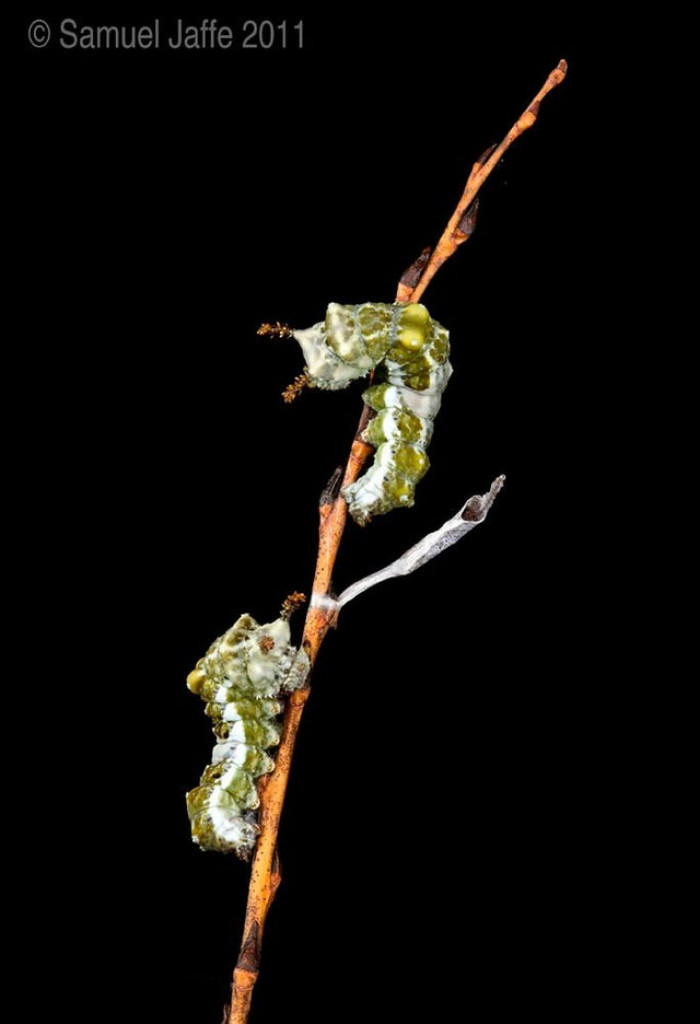
Meet The Viceroy Caterpillar, A Wise Creature That Camouflages Itself As Bird Poop To Avoid Being Eaten
The Viceroy Caterpillar is a really cool and smart creature!

Viceroys don't resemble regular caterpillars at all. In actuality, they resemble... bird droppings (exactly what you read).
Viceroys are making an effort to avoid becoming food for birds by cleverly coloring their bodies to resemble bird dung. However, viceroys must also behave somewhat like bird droppings in order to pass as convincing bird droppings.
Caterpillars of many different kinds frequently rest on the undersides of leaves. In fact, a good place to stay out of the sun and hide from predators is under a leaf.
However, Viceroy caterpillars congregate on the tops of leaves, which is the place where bird poop makes the most sense to be. Although they are right there in plain sight, their camouflage as bird feces helps to prevent them from being eaten.
The picture which you'll see below shows a white structure branching off to the right of the twigs. That is an overwintering shelter called a hibernaculum.
Viceroy caterpillars in their early instars construct hibernacula in the late summer or early fall, when the weather starts to chill and the leaves start to wither. They hide within a leaf until springtime, wrapping the leaf in silk and using it to firmly fasten it to its twig.
Viceroy caterpillars have an advantage over other species of caterpillars in that they can quickly emerge from their hibernacula and start feasting on the spring foliage as soon as their plant's first tiny leaves start to appear in the spring.
Redditor u/DavenportBlues has an interesting piece of information to share with the TodayILearned subreddit page
 u/DavenportBlues
u/DavenportBluesViceroy caterpillars in their early instars construct hibernacula so they can hide in them until springtime
 thecaterpillarlab.org
thecaterpillarlab.orgWe've gathered a bunch of comments from Redditors for you to read through below.
How to know if he is a king
 Reddit
RedditThis Redditor makes use of this camouflage as well
 Reddit
RedditSpicebush swallowtail caterpillars do the same and it doesn't work?
 Reddit
RedditIt definitely works, I guess
 Reddit
RedditAn adult camouflages itself as a monarch butterfly
 Reddit
RedditIt was originally believed that the Viceroy's markings, which closely resemble those of the dangerous Monarch butterfly, were a defense mechanism against predators. As a result of the two butterflies being equally harmful, protection against birds is now mutually increased.
With the exception of a black horizontal stripe running along the bottom of its back wings, adult Viceroys mimic the color pattern of the Monarch pattern. Its wings' undersides resemble their tops, whereas the Monarch's are much lighter.
Someone wants to join in
 Reddit
RedditEvolution never accounted for this Redditor
 Reddit
RedditThis is definitely the ultimate camouflage
 Reddit
RedditAs a Viceroy, you definitely have to go through some sh*t
 Reddit
RedditIt's the compliment for me
 Reddit
RedditViceroy butterflies are camouflaged to look similar to monarch butterflies which are poisonous
 Reddit
Reddit
Look for willow, aspen, and poplar trees in meadows and around the exposed edges of wet regions if you want to see viceroys. Your chances of discovering a viceroy will rise if you come across plants that are smaller and different from other species of the same kind.
A hibernaculum that has been abandoned or the top of a leaf might contain one as well.
Maryjane







